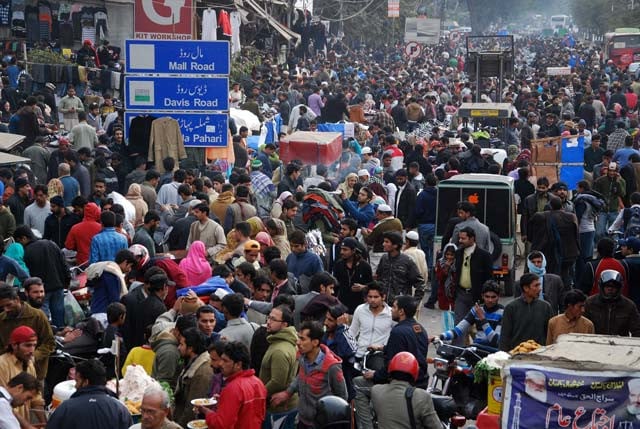By Shahbaz Rana
Published in The Express Tribune on July 19, 2024
ISLAMABAD:
The country’s population growth rate has accelerated to the 27th fastest in the world and its 79% people are young under the age of 40 years, revealed findings of the 7th Population Census that the government officially released on Thursday.
The results also officially confirmed that 39.5% people above the age of 10 years were illiterate and 36% or 25.4 million children were out of schools.
With these figures no nation can progress, admitted Ahsan Iqbal, the Federal Minister for Planning while launching the results of the 7th population census completed last year.
The official figures come at a time when the country has just entered into a three-year staff level agreement with the International Monetary Fund a programme that targets yet another low economic growth phase for the next three years.
The total population is 241.49 million with 51.48 % male and 48.51% female. The household size has slightly reduced to 6.3 individuals compared to the previous census of 2017.
The official launching of the results indicates a discrepancy which has again emerged in Karachis population. The report has mentioned Karachi’s population at 18.87 million at multiple occasions but on its website the Pakistan Bureau of Statistics has mentioned the citys population at 20.3 million- a difference of about 1.5 million individuals.
Lahore remains the second most populated city with 13 million people, followed by Faisalabad (3.7 million), Rawalpindi (3.4 million), Gujranwala (2.7 million) and Multan (2.2 million).
Pakistan’s population increased to 241.5 million in 2023 at a growth rate of 2.55%, said Iqbal, regretting that the country was among the top 30 fastest populating nations. At this pace we will be 480 million individuals by 2047, he added.
What has become a factor of change in Pakistan, the results showed that 190.3 million population or 79% is below the age of 40 years.
This is the age group that needs jobs, political and economic stability . These are the factors that are missing in Pakistan and according to many experts are the reasons behind the brain drain in the country.
Iqbal said that the increasing population was putting immense pressure on the scarce resources of the country and adversely affected per capita income and living conditions of the citizens.
Religion
According to the census, the percentage of Muslim population has nominally decreased from 96.5% to 96.4%. However, in absolute terms the number of Muslim people increased by 31.3 million to 231.7 million individuals.
Compared to this, the share of the Christian population has increased from 1.27% to 1.37%, as their total population increased by another 658,740 to 3.3 million. But the share of Hindu population reduced from 1.73% to 1.61%. The share of Qadiani people reduced in both percentage and absolute terms to 0.07% or by 29,053 to 162,684 individuals, according to the census.
Linguistic breakdown
One of the questions in the population census was about the mother-tongue. The number of Urdu speaking people have increased to 9.3% by 2023. But Punjabi-origin people have reduced to 37%. There is also a reduction in the Sindh language speaking people from 14.6% to 14.3%. the Pashto speaking people reduced from 18.3% to 18.2% but Balochi-language people increased from 3% to 3.4%.
The number of Saraiki-language people was reduced from 12.2% to 12%. About 66% of the population in Pakistan is reported as married.
The censuss detailed results and insights on various socio-economic indicators are being disseminated for wider use in research, policy and planning to ensure evidence-based decision making and capitalize census data utilization.
The census has also digitally geo-tagged almost 38 million structures, enumerated 250 million people across 20 demographic variables, and documented 38 million households.
Pakistan has more mosques than wholesale shops and factories. According to the census, there are 611,000 mosques and 20,0000 madarasas in Pakistan. But there were only 193,000 factories and 345,000 wholesale shops. The retail shops were numbered at 3.1 million in 2023.
Literacy Rate
The results showed that 60.5% of the population aged ten years and older in Pakistan is literate. This ratio is 68% in males and 52.8% in females.
It would be illusionary to see a dream of economic growth without increasing the literacy rate to 90%, said Iqbal. He said that a nation with a 23% female labour force participation rate also cannot grow.
Pakistans socio-economic planning has suffered badly due to the dominance of the finance ministry over the planning ministry. The finance ministry sees everything with the prism of fiscal affairs and has ended up in creating more socioeconomic distortions.
The census results also showed that 25.4 million children, which accounts for 36% of the children aged between 5 and 16 years, are currently out of school. This ratio is highest in Balochistan with 58%, followed by that of Sindh at 46%, K-P at 37% and Punjab with 27%.
According to these results, 84% households have electricity access, while 8% households utilize solar panels as a source of energy at homes.






